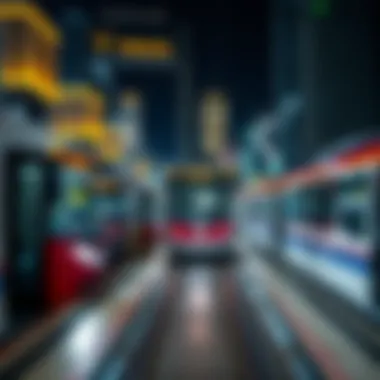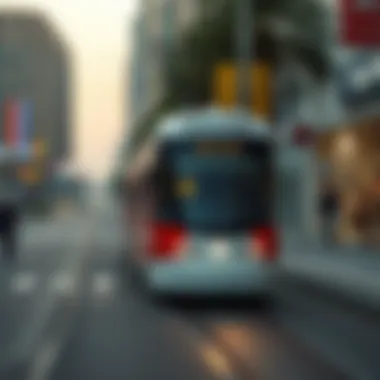Exploring the Dubai Tram System: A Comprehensive Guide


Intro
Dubai, a city that never ceases to amaze, is constantly evolving and embracing modernity. One of the crown jewels of its urban development is the tram system. This guide will take you through the ins and outs of the tram map in Dubai, shedding light on its routes, infrastructure, and crucial role in public transportation.
As we explore this comprehensive overview, you'll learn how the tram network complements the existing public transport options and offers an efficient, accessible means of navigation across the bustling metropolis. With increased urbanization, the integration of trams is not just about transport; it's a key player in enhancing the quality of life for both residents and tourists. This isn't just another public transport system; it's a lifeline woven into the very fabric of Dubai, fostering community connection and mobility in one of the world's fastest-growing cities.
As we delve deeper, you'll find vital insights that will not only inform but also guide decision-making for investors, homebuyers, developers, and expatriates keen on understanding Dubai’s burgeoning real estate landscape.
Understanding Dubai's Transit Landscape
Comprehending the transit landscape in Dubai isn't just about knowing how to get from point A to point B. It's an intricate web of transportation options that reflects the city's rapid growth and its ambitions for a modern future. Dubai's public transport system has become a framework that supports not only daily commutes but also tourism and economic activity. The significance of understanding this system lies in its capacity to enhance urban mobility, reduce traffic congestion, and connect various regions seamlessly.
The efficiency of the transit network directly contributes to the city’s livability. By improving accessibility, it ensures that residents can move smoothly throughout the city — a crucial factor for investors and homebuyers contemplating property selections. Knowing how to navigate this landscape is invaluable for expatriates as well, who often rely on public transport during their transition.
Overview of Public Transport in Dubai
Dubai's public transport system includes a mix of buses, taxis, water taxis, the metro, and the tram network. This diversity of transport options allows for flexible commuting based on personal schedules and specific destination needs. The Roads and Transport Authority (RTA) manages this network, ensuring it's well-integrated and user-friendly.
- Buses: Covering most areas, they provide a cost-effective way to travel across the city. The extensive routes make it convenient for both locals and visitors to explore different neighborhoods.
- Metro: A shining star of the public transport system, the Dubai Metro runs on elevated tracks, reducing traffic on the roads and offering a swift service to various districts. It spans miles, making it a vital piece of the city's mobility puzzle.
- Water Transport: Dubai's waterways are utilized through abras and ferries, providing beautiful views. This also connects traditional areas to modern parts of the city, blending old and new.
The incorporation of trams, which primarily operate in the vicinity of the Marina district, adds another layer to the network. By connecting major hubs and popular destinations, they enhance service coverage, making public transport even more attractive for daily use.
The Role of Trams in Urban Mobility
Trams serve a unique purpose in Dubai's public transport ecosystem. They are not merely an additional mode of transport; they are a key solution to urban mobility challenges in a rapidly growing metropolis. As the city expands, trams present a viable way of managing transportation needs, especially in densely populated areas.
Benefits of Trams:
- Sustainability: They provide an eco-friendlier option than cars, encouraging more people to opt for public transport over personal vehicles.
- Accessibility: Trams often run on dedicated tracks, providing a reliable means of transport that sidesteps the congestion often seen on main roads.
- Community Integration: By linking vital areas like shopping districts, residential zones, and business hubs, trams foster social interaction and community activity.
In a nutshell, understanding Dubai’s transit landscape, with its elaborate systems of trams and other transport means, is vital for investors, homebuyers, agents, and anyone looking to make a foothold in this ambitious city.
The Tram Map: Layout and Features
Understanding the tram map in Dubai is key to unlocking the richness of the city’s public transportation capabilities. The layout and features of the tram map provide essential insights into how the tram system operates and connects with other transport modes, ultimately improving daily commutes for both residents and visitors. Unique in its design, the tram infrastructure complements the overall urban landscape, making it vital for anyone looking to navigate Dubai successfully.
Overview of Tram Routes and Stations
The tram system in Dubai boasts a carefully plotted network of routes that cover crucial areas within the city. Each route is strategically planned to ensure maximum accessibility for commuters.
The tram routes include:
- Route T1: This is the main line, stretching from Al Sufouh to the Dubai Marina area, featuring essential stops close to major attractions such as Jumeirah Beach and the Mall of the Emirates.
- Route T2: It connects with the bustling areas of the Dubai Marina and the Palm Jumeirah through scenic views that attract tourists and residents alike.
The tram stations are designed with user-friendliness in mind, featuring elevators, clear signage, and digital displays that keep passengers informed about tram schedules. They serve as gateways to key destinations, whether for work, leisure, or shopping. Having a clear map allows users to pinpoint their starting and ending points effortlessly.
This network doesn’t just serve as a means of transport; it embodies a commitment to making commuting a streamlined experience, particularly in high-traffic regions. Integration with other transport systems, like the Metro and bus services, enhances its effectiveness as a single component of a larger transport narrative.
Notable Stops and Connections


While all stops serve their purpose, some stand out as essential connections that enhance travel convenience. Key stops include:
- Dubai Marina Tram Station: A hub for leisure and entertainment, connecting visitors to the marina area and nearby waterfront cafes.
- Jumeirah Beach Tram Station: This stop provides easy access to the beach, making it a popular choice for families and tourists alike.
Each of these stations connects to other modes of transport, such as the metro lines and bus networks, highlighting the tram's role in creating a seamless commuting experience. The connections made by the tram further emphasize the thoughtful planning of public transport in Dubai, enabling users to transition with minimal hassle.
In a nutshell, the tram map serves as a visual guide to navigating the intricacies of urban life in Dubai. With routes designed for efficiency and notable connections that blend with the city's vibrant atmosphere, understanding the tram map is fundamental for anyone wanting to explore the rich tapestry of what Dubai has to offer.
Operational Aspects of the Tram System
Understanding the operational aspects of the tram system is crucial for both commuters and investors in Dubai. This section sheds light on the nitty-gritty of how the tram network functions, its timing, and fare structures. The effectiveness and efficiency of any transit system directly impact urban mobility, making this a significant area of interest.
Tram Frequencies and Timings
The frequency of trams is one of the cornerstones that determine a commuter's experience. Currently, the trams in Dubai's network run every 10 to 15 minutes during peak hours, which allows for a seamless commuting experience. Off-peak hours also see an admirable frequency, ensuring that those who ride the trams at varied times do not have to wait long.
- Weekdays: Peak hours are notably packed, while mid-afternoon journeys tend to be lighter.
- Weekends: Frequencies can vary, often increasing to cater to the leisure crowd that frequents malls and attractions along the routes.
Another key consideration is the timeliness of service; trams generally adhere to a rigid schedule that commuters can rely on, reinforcing the reliability of the system. With clear digital displays at stations showing real-time updates, passengers know precisely when to expect their ride.
Fare Structure and Payment Methods
Navigating the fare system is straightforward yet requires some knowledge. The costs depend on the distance traveled, reflecting a fair value for services rendered. According to the current structure, passengers benefit from several pricing tiers:
- Single Journey Ticket: Priced at around AED 3 for short distances, increasing gradually based on distance.
- Multiple Journey Pass: Offers an economical option for frequent users, costing approximately AED 20 for a daily pass.
Payment methods are modern and cater to a tech-friendly audience. Passengers can use:
- Nol Card: A reloadable smart card accepted across all public transport in Dubai, including metro and buses.
- Mobile Payments: Options such as Apple Pay and Google Wallet are accepted at tram kiosks, allowing for a seamless transaction experience.
"Convenience is key when investing in urban infrastructure. A reliable tram system attracts more users, thereby enhancing property values around its network."
Ultimately, an understanding of the operational aspects emphasizes the tram system’s critical role in Dubai’s transport fabric. It not only eases travel for residents but also contributes hand-in-hand to urban growth, making it a focal point for prospective investors and developers.
Integration with Other Transport Modes
The integration of Dubai's tram network with other modes of public transport is crucial in creating a seamless commuting experience for residents and visitors alike. By connecting various transport options, the tram system does not only enhance mobility but also fosters the development of a comprehensive urban transport ecosystem, offering numerous benefits for the city's growing populace. Such an integration means reduced waiting times, increased accessibility, and improved overall efficiency of the transport network.
There are several key elements to consider when discussing integration:
- Interconnectivity: The ability of trams to link seamlessly with metro stations and bus routes amplifies the overall reach of public transport. This not only means more convenience but also encourages the use of public transport over private vehicles.
- Convenience: With well-marked connections and easy transfers, commuters can plan their journeys more efficiently. This reduces travel time and enhances the user experience.
- Cost-Effectiveness: When different modes of transport operate together, it often leads to reduced fare prices for those making transfers. It becomes an economical choice for daily commuters.
Ultimately, introducing a unified transport mechanism mitigates congestion and reduces the carbon footprint associated with urban travel.
Connecting with the Metro System
The tram system in Dubai works hand-in-hand with the Metro, creating a robust comprehensive travel network. The Metro’s extensive reach through the city is complemented by the tram system’s more localized service, enabling users to travel directly to their destination without the hassle of multiple transfers.
Several key aspects highlight the synergy between the trams and Metro:


- Direct Transfers: Identify areas where tram stops are strategically placed near Metro stations, making transfers a breeze.
- Unified Ticketing System: Leveraging the same payment system for both transport modes reduces the friction associated with fare collection. E-tickets give commuters flexibility, allowing them to hop onto a tram or a train without needing a separate payment method.
- Increased Frequency: The coordination of tram and Metro timings ensures minimal waiting periods. This partnership keeps the flow of commuters smooth, especially during peak hours.
As you navigate the city, utilizing both tram and Metro systems can transform your travel experience into one that is both efficient and enjoyable.
Linking with Bus Services
The integration of the tram system with Dubai's extensive bus services is another cornerstone of effective urban mobility. Buses complement tram services by extending access to areas that are not served by tram lines, thus widening the public transport reach significantly.
Consider the following factors that enhance this connection:
- Strategic Bus Stops: Many bus routes connect directly with tram stations, allowing for easy transfers between modes. This is particularly useful in connections to areas further away from the main tram lines.
- Coordinated Scheduling: Synchronizing bus and tram schedules helps reduce wait times for passengers, allowing for easier transitions between transport modes.
- Easier Access for Expats: With Dubai being home to many expatriates, integration with bus services provides vital links to residential areas and workplaces that may be far from tram stops.
The seamless interplay between trams and bus services ensures that all commuters can navigate Dubai with less hassle and more flexibility, fueling the city's vision of becoming a global smart city.
Impact on Urban Development
The tram system in Dubai is not merely a means of transportation; it serves as a pivotal axis around which urban development revolves. With its intricate network of routes, the tram significantly shapes the city’s development strategy, knitting together different neighborhoods while enhancing the overall appeal of the locale. This evolution is crucial for investors, homebuyers, and developers, as it creates opportunities for growth and appreciation.
Enhancing Accessibility to Key Areas
Accessibility is a cornerstone of urban mobility, and the tram infrastructure in Dubai elevates this concept to new heights. By connecting key areas—such as business districts, residential hubs, and leisure spots—the tram offers a pragmatic solution for both residents and tourists. Many key attractions, including the Dubai Marina and Jumeirah Beach, lie within easy reach of tram stops, which essentially transforms the way people interact with these locales.
- Enhanced Connectivity: The tram provides seamless transitions to other modes of transport, making it easier for people to navigate the city. Commuters can easily switch to the Metro or bus services, creating a unified transport ecosystem.
- Reduction of Traffic Congestion: With trams, fewer cars on the road translates to less traffic congestion. This not just improves the experience of those who drive, but it also fosters a more walkable environment.
- Support for Businesses: Areas close to tram stations often see an uptick in foot traffic. Small businesses and retail stores profiting from the increased presence of potential customers represent a win-win scenario.
With all these enhancements, property values in these connected regions frequently climb, making them attractive options for those looking to invest in the rapidly changing landscape of Dubai.
Influence on Property Values
The presence of a robust tram network can have a significant impact on property values in adjacent developments. The accessibility afforded by trams not only attracts residents but also leads to increased demand for real estate in those areas. Investors keen on capitalizing on this trend should pay attention to the following key factors:
- Proximity to Tram Stations: Properties situated near tram stops generally appreciate faster than those that are not. The promise of convenience often sways potential buyers or renters.
- Enhanced Marketability: A location blessed with easy access to public transit is inherently more marketable. This gives homeowners and developers leverage in negotiations, whether buying or selling.
- Risks and Challenges: Though increased property values might seem universally positive, it's vital to consider potential downsides, such as noise and congestion that may accompany the development of tram routes. Balancing these factors is important for a holistic understanding of the property landscape.
According to various studies, areas that incorporate public transit options often see a rise in property values that'll attract individuals looking for a blend of convenience and lifestyle. Understanding these dynamics can guide both homebuyers and property developers in making informed decisions.
The tram's compatibility with expansion strategies places it at the forefront of Dubai's infrastructure efforts, fostering an environment that is ripe for investment and innovation.
As Dubai continues to grow, so will the relevance of its tram system. The intertwining of urban development and public transport hints at a future where convenience, accessibility, and investment potential are more connected than ever. This integration not only invites prosperity but also enriches the everyday lives of those who call Dubai home.
Consider exploring further on accessibility studies and property market trends at Wikipedia or Britannica for deeper insights.
Challenges and Future Developments
In the rapidly evolving landscape of urban mobility in Dubai, the tram system is both a crucial asset and a subject of various challenges. Understanding these hurdles and the plans to expand and enhance the tram network is essential not only for current users but also for investors, homebuyers, and urban developers. This section delves into operational challenges faced and the ambitious future expansion plans that promise to shape the tram system in the coming years.
Operational Challenges Faced
The tram system in Dubai, while designed to be state-of-the-art, does encounter certain operational difficulties. Among the most significant challenges are:
- Capacity Constraints: During peak hours, the trams often run at full capacity. This leads to overcrowding, which curtails the experience for commuters and might discourage potential users.
- Maintenance and Downtime: Regular maintenance is vital for the seamless operation of the trams. However, scheduled repairs or unexpected malfunctions can cause service disruptions, affecting punctuality and reliability.
- Integration Issues: The tram network, although connecting well with the metro and bus services, sometimes fails to offer seamless transfers. Delays in coordinating schedules can result in annoying wait times for commuters moving between modes of transport.
- Public Awareness: Many residents are still unfamiliar with the tram routes, leading to underutilization. Hence, there is a pressing need for effective communication strategies to encourage public engagement.


"The tram systems often run on short notice or adjusted schedules, challenging regular riders to stay informed."
Addressing these challenges is crucial for enhancing the user experience and maximizing the system’s potential.
Future Expansion Plans
Despite the operational hurdles, there is a clear vision for the future of the tram system. Expansion plans aim to address current issues while improving accessibility and connectivity for the populace. Key aspects of these future plans include:
- New Routes: There are proposals for additional tram lines that will extend into less accessible neighborhoods, serving to promote greater inclusivity within the transportation network.
- Increased Frequency: To tackle capacity constraints, plans are in motion to offer more frequent tram services, particularly during rush hours. This will help alleviate overcrowding and improve overall satisfaction among commuters.
- Smart Technology Integration: Future developments propose the inclusion of smart technology for real-time updates and more efficient operations. This can include enhancements such as a mobile app for real-time tracking and notifications regarding schedules or disruptions.
- Sustainability Focus: As Dubai aims for a more sustainable urban environment, there will be an emphasis on eco-friendly energy sources for tram operations. Transitioning to electric or hybrid systems could significantly reduce the carbon footprint.
- Collaborations and Stakeholder Engagement: Future expansion is not solely a transit authority initiative. There’s an ongoing dialogue with property developers and urban planners to create a comprehensive transport-oriented development strategy, ensuring that new tram routes align with future urban growth.
User Experience and Accessibility
User experience and accessibility are at the forefront of ensuring that the tram system in Dubai serves its riders effectively. A well-thought-out design can make public transport not just functional but also enjoyable. For investors and potential homebuyers, understanding the user experience can lead to better decisions regarding property in proximity to tram routes. These factors can impact future property values and the attractiveness of local communities.
Design Considerations for Users
When it comes to tram design, several elements contribute to a seamless experience for users:
- Station Layout: Each tram station should be designed for easy navigation, with clear signage and intuitive layout. Riders appreciate when a station feels open and welcoming, preventing confusion at critical junctions.
- Accessibility Features: Ensuring that all users, regardless of mobility challenges, can access trams is essential. Features like ramps, tactile paths, and audio announcements cater to a variety of passengers, including elderly people and those with disabilities.
- Real-Time Information: Providing timely updates about tram arrivals and departures helps users plan their journeys. Digital screens at stations and in trains need to be intuitive and clear, displaying information in a manner that's easy to digest.
- Comfort During Rides: The comfort of seating, standing space, and even the air conditioning are also vital. A pleasant ride can significantly enhance the appeal of using trams, making passengers more likely to choose this mode of transport.
Incorporating these design elements can lead to a more user-friendly tram system that meets diverse needs.
Feedback from Commuters
Listening to those who use the tram systems is one of the best ways to understand its effectiveness. Feedback from commuters often highlights what works well and what doesn’t.
Many commuters appreciate the convenience of the tram system, often emphasizing:
- Efficiency: Riders frequently mention the trams as a quick way to get around. Comparatively, in a city known for its dense traffic, a reliable tram can save precious time.
- Comfort: Some riders have noted that the trams are generally clean and well-maintained, enhancing the overall experience, which is crucial, especially during the scorching summer months.
However, some feedback also points out areas needing improvement:
- Crowding during Peak Hours: Many complain about overcrowded trams during rush hours. Addressing this issue through additional service frequency can improve overall satisfaction.
- Limited Coverage: There are concerns regarding the extent of tram routes and their connectivity to key areas of the city. Many wish for expansion plans to include underserved neighborhoods.
"Public transport that prioritizes user experience fosters a more engaged and satisfied commuter base."
By actively considering feedback from users, authorities can adapt the tram system to better serve the community, ultimately enhancing urban mobility and connectivity in Dubai. For more insights, commuters often share their experiences on platforms such as Reddit and via social media forums like Facebook.
Fostering open communication with users can lead to continuous enhancements in tram infrastructure, ensuring that it meets the evolving needs of its riders.
Closure
The conclusion of this guide serves as an essential reflection on the intricacies of Dubai’s tram system and its relevance in the urban transport landscape. The tram network is more than just an addition to public transport; it has woven itself into the fabric of daily life in Dubai, connecting residents, businesses, and visitors. By examining the functionalities discussed throughout the article, the importance of the tram system becomes apparent, particularly in enhancing overall urban mobility.
Summary of Findings
The tram system in Dubai boasts a well-thought-out map, which complements other public transport facilities, creating a seamless journey for users. Key findings that emerged from our exploration could be summarized as follows:
- Tram Networks: The routes are strategically laid out to cover high-density areas, leading to effective transportation.
- Integrated System: The connection with both the Metro and bus services allows for a fluid transit experience, reducing waiting times and enhancing commuter convenience.
- User-Centric Design: Features like accessibility options cater to a broader demographic, ensuring that everyone from daily commuters to tourists can utilize the service comfortably.
The synthesis of these elements illustrates how well-planned tram infrastructure contributes to the overall efficiency of the public transport system in Dubai.
Final Thoughts on the Tram System's Role
In assessing the tram system’s role within the broader context of urban development, it is crucial to recognize its dual impact on both mobility and social interaction. This system does not only facilitate the movement of people but also plays a pivotal role in shaping how communities interact and grow.
- Enhancing Accessibility: Areas that were once hard to reach are now easily accessible, thus promoting business growth and tourism.
- Influencing Property Values: As accessibility improves, property values in proximity to tram stations tend to increase, indicating that real estate developers should consider the transit map when planning new projects.
- Supporting Sustainability: The tram system reflects a commitment to environmentally friendly public transport, encouraging more people to opt for public commuting rather than personal vehicles.



